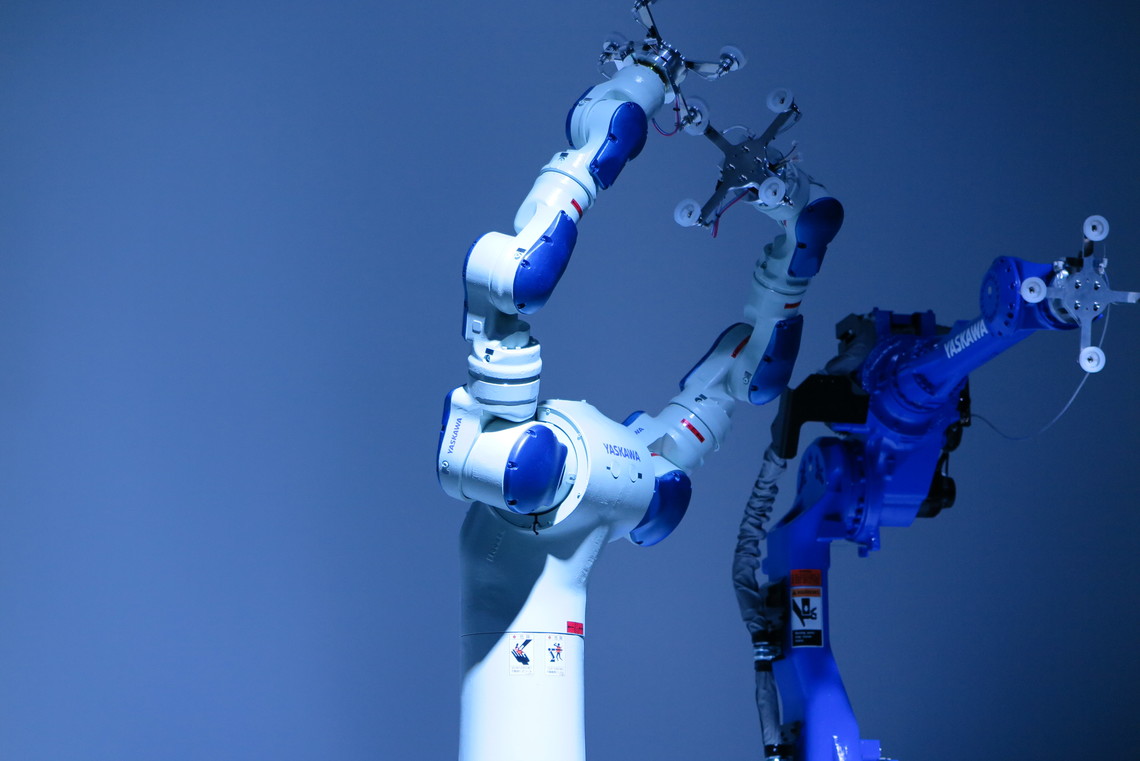Yaskawa Electric celebrated its 100th anniversary in April. While Yaskawa is known for the buzz-worthy project movie 'YASKAWA BUSHIDO PROJECT' featuring its industrial robot "MOTOMAN MH24" challenging the divine art of iaido sword drawing, there are actually other stories of challenge. That is the stage performance held at the commemorative ceremony. Centered on the theme of "human-robot collaboration," it fused Yaskawa Electric's industrial robots with Rhizomatiks' technology and experience. This time, we report on the production process, which is rarely seen.
Edited and Compiled by: Aki Kanahara, Dentsu Inc. Event & Space Design Bureau
Japanese robotics technology is currently attracting global attention. Amidst declining birthrates, an aging population, and a shrinking working-age population, robotics holds the potential to solve societal challenges across diverse fields—from manufacturing production lines to healthcare and nursing facilities, and from agriculture and construction to infrastructure work sites. It promises to alleviate labor shortages, free workers from excessive burdens, and boost productivity. As expectations for robotics grow stronger than ever, both domestically and internationally, Yaskawa Electric celebrated its 100th anniversary on April 28, 2015.
Yaskawa Electric began as a custom manufacturer of electrical equipment for coal mines and has grown into a global enterprise with sales exceeding ¥400 billion, boasting world-leading market share in cutting-edge technologies like robotics.

Dual-arm 15-axis articulated robot: MOTOMAN-SDA10
As part of its 100th-anniversary initiatives, Yaskawa realized the Robot Village concept. The Robot Village consists of "YASKAWA Forest," the "Yaskawa Electric Mirai Museum," the "Robot Factory," the "Headquarters Building," and the "Welfare Building." Through Robot Village, Yaskawa Electric aims to communicate the joy and wonder of manufacturing, striving to become a company deeply rooted in the community and beloved by all. For the stage performance during Part 1 of the Robot Village Opening Ceremony, Yaskawa Electric teamed up with Rhizomatiks to create a stage that impressively conveyed the future of Yaskawa's robots to the world.
The stage theme was "Human-Robot Collaboration." This performance embodied the relationship between robots and humans that Yaskawa has pursued and continues to pursue. The company believes that the future of robot technology lies not in robots replacing humans, but in their collaborative role with people.
The overall production design was led by MIKIKO, a top pioneer in cutting-edge entertainment production techniques, and Ryzomatiks' Daito Manabe, with technical direction by Ryzomatiks' Motoi Ishibashi. The process involved creating CG animations of the robotic movements they designed. Yaskawa's technical team then input these movements into the robots using the company's proprietary program systems. As the programming progressed, it became clear that industrial robots, lacking temporal awareness, struggled to move in sync with musical counts like humans. Through collaboration between the Yaskawa technical team and the Rhizomatiks team, they succeeded in creating precise robotic movements.

To the Yaskawa Electric technical team, the Human Resources and General Affairs Department staff, and the Rhizomatiks team
On stage, we created scenes where robots pass cubes to each other, expressing the collaboration of industrial robots. Later, in scenes where they dance with human dancers, the direction evolves to make the robots' movements appear more human-like. Furthermore, since Yaskawa Electric originated from "motors," we incorporated a flying cube performance controlled by motor movement.

Cube suction test
Regarding cube movement, since adjustments might be needed until the very end, we used a method involving sensing technology—reading positions with infrared cameras and projecting them—rather than using pre-edited footage for projection mapping. While this technique was cutting-edge until very recently, we employed it as a backup plan for this stage.

Projection mapping adjustments
Finally, completing the performance stage using Yaskawa Electric's industrial robots marked a significant step forward as a pioneer for the emerging combination of "robots and entertainment." Programming industrial robots requires far more detailed adjustments than we might imagine.
While the range of movements is expected to expand as industrial robots continue to evolve, the ability to understand those movements and organize them into entertaining expressions is indispensable for creating "Robotics × Entertainment." Collaborating in this field with teams like Yaskawa Electric and Rhizomatiks, both challenging cutting-edge technology, proved to be an immensely valuable experience.

Group photo after the performance (Yaskawa Electric technical team, Rhizomatiks, Elevenplay, Dentsu Inc.)
Next time, we'll share interviews with Daito Manabe and Motoi Ishibashi from Rhizomatiks, and Shinichiro Sekiguchi from Dentsu Inc. Tech, who worked on the stage production!






